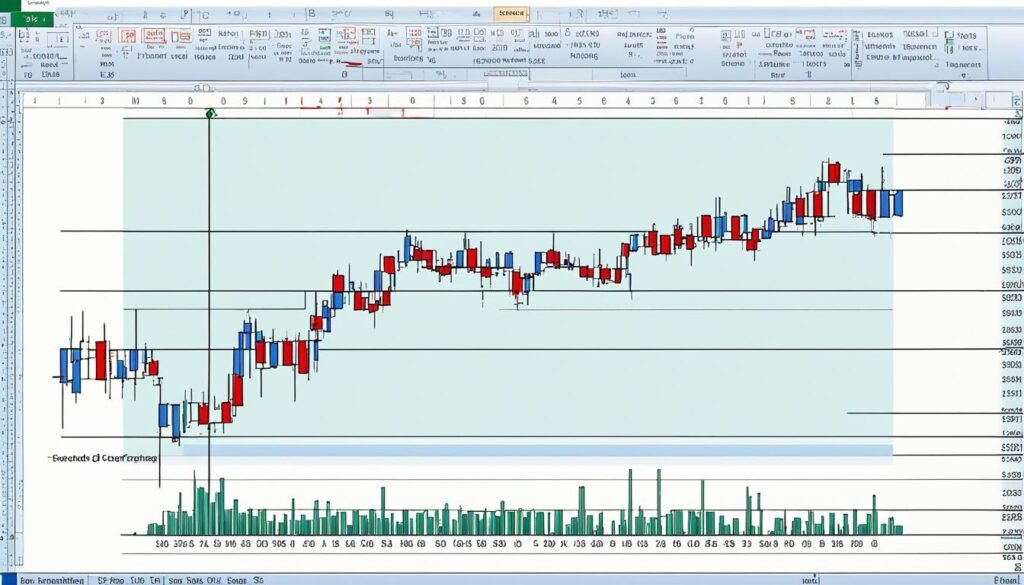For both the novice and seasoned investor, the imperative to continuously advance one’s trading acumen is evident. Success in the ever-changing financial landscapes demands astute adjustments in trading methodologies, be it in forex trading, stock trading, cryptocurrency trading, futures trading, or options trading. This discourse seeks to elaborate on the paramount trading insights and strategies that have propelled adept investors towards superior performance and sustained profitability.
Inasmuch as the creation of a holistic trading plan and the adoption of sophisticated trading technology are instrumental, our discussion will also illuminate the crucial aspects to invigorate your trading paradigm. It will address fortification of your trading capital, the cultivation of an erudite market perspective, and the sustenance of requisite discipline and mindset for navigation within the trading sphere.
Key Takeaways
- Treat trading as a business, not a hobby, with a focus on planning, education, and discipline.
- Develop a robust trading plan with clearly defined entry, exit, and risk management rules.
- Leverage technology to backtest trading ideas, monitor market conditions, and execute trades efficiently.
- Prioritize capital preservation by implementing sound risk management practices.
- Continuously educate yourself on market dynamics, economic factors, and trading strategies.
Treating Trading as a Business
Discerning traders acknowledge that perceiving trading as a business establishes a foundation for enduring achievement, distinct from pastime or employment. This paradigmatic alteration is indispensable for trading strategies as well as the calibration of realistic trading expectations. Analogous to any entrepreneurial pursuit, trading necessitates meticulous preparatory work, perpetual learning, and an unyielding dedication to mitigate the inherent risks and volatilities.
Planning Your Strategies
The inception of adept trading strategies involves a meticulously constructed blueprint that accommodates the oscillations and advancements within the trading sphere. It is imperative to stay abreast through continuous refinement of knowledge, integrating the most recent trends, data, and strategic analyses into your trade mores. Attain a profound connaissance of the domains in which you intend to transact, and habitually appraise and recalibrate your methodologies to harmonize with the flux.
Setting Realistic Expectations
Certitude in trading as a business demands adherence to realistic trading expectations. Trading encompasses overheads—commissions, and technical fees—as well as risks, levies, and the cognitive burden of navigating unpredictability. Engage with trading akin to an entrepreneurial pursuit of distinguished stature, enhancing its auspices and broadening the vista for sustainable achievement.
Developing a Trading Plan
Initiating a path towards success in trading necessitates the crafting of a meticulously detailed trading plan. This blueprint encompasses a refined trading strategy, the doctrines governing your market entries and exits, and the financial management principles. The fundamental aim is to relegate emotional and impulsive decision-making to the periphery through a methodology steeped in empirical research and market acumen.
The bedrock of any robust trading plan is constituted by exhaustive backtesting coupled with a meticulous scrutiny of market trends. Prior to the enactment of strategies in genuine market conditions, it is imperative to subject them to historical assessment. This critical evaluation unveils potential vulnerabilities, allowing for the honing of trading rules and a deeper navigation of the market landscape.
Upon integration of your meticulously curated trading plan, the commitment to its unwavering application, particularly in scenarios where deviation appears lucrative, emerges as indispensable. Adherence to this rigidity poses challenges, yet stands as a linchpin for attaining enduring trading prosperity. Such consistency immunizes against the whims of haphazard decision-making, thereby sustaining the strategic precision of the trading approach.
| Key Elements of a Comprehensive Trading Plan |
|---|
|
Leveraging Technology
In an era defined by rapid technological evolution, discerning traders are increasingly deploying sophisticated tools and platforms to augment their trading acumen. Crucial among the myriad applications of technology are the procedures of backtesting trading ideas and monitoring trades on the go.
Backtesting Ideas
The proficience in backtesting trading ideas against historical data equips traders with a formidable method to assess their strategies, devoid of actual financial risk. Through the simulation of transactions and an extensive retrospective analysis, vulnerabilities and inaccuracies in trading schemes are uncovered. This critical evaluation facilitates the refinement of decision-making protocols, leading to the articulation of strategies that are both coherent and lucrative within market contexts.
Monitoring Trades on the Go
Amidst the incessantly evolving landscape of trading, the capacity to monitor trades and market developments on the go constitutes a discernible competitive advantage. The advent of mobile trading applications and platforms has bestowed traders with the capability to remain seamlessly connected to market dynamics. This phenomenon empowers the timely exploitation of burgeoning prospects and the swift adjustment to market vicissitudes.
The amalgamation of the foremost trading technology with a discerning deployment strategy enables traders to carve out a competitive advantage, refine their decision-making processes, and achieve a superior level of trading proficiency.
Protecting Your Trading Capital
Safeguarding trading capital assumes paramount significance in the realm of trading. The trading account stands as the cornerstone of one’s trading enterprise, with its restoration post-substantial loss often presented as an arduous challenge. Essential to this process is the elevation of trading capital protection as a principal directive, underpinned by the deployment of stringent risk management methodologies.
Deploying judicious avoidance of unnecessary risks emerges as a pivotal stratagem in fortifying one’s financial assets. This necessitates exhaustive evaluation of each prospective transaction, comprehensive apprehension of potential detriments, and the daring of risks within one’s loss-tolerance threshold. Acknowledging the unattainability of total loss obviation in trading’s volatile domain, the primary aim transmutes into the constriction of probable diminutions on singular transactions, ensuring the integrity of the cumulative trading capital.
Vital also is the application of efficacious risk management methodologies in capital preservation endeavors. This comprises the imposition of stringent stop-loss imperatives, portfolio diworsification, and the employment of siring sizing schema to circumscribe financial jeopardy. Such a methodical risk oversight serves to mitigate the repercussions of isolated trading setbacks, fostering resilience against the undulations of market vicissitudes.

The capability to keep trading capital intact represents a pivotal competence that demarcates triumphant traders from their less successful counterparts. Manifested through an ethos of circumspection and rigor, this approach underwrites a trader’s capacity to confidently and tenaciously navigate market complexities, thereby propelling them towards sustained trading triumph.
trading
The path to mastery in trading is an unceasing evolution, requiring perpetual engagement in market education and unrelenting learning. A trader’s ethos mandates a perpetual student status, incessantly aiming for the augmentation of insights into the market dynamics influencing the financial cosmos. Via meticulous market research, traders procure indispensable understandings on the stimuli behind price fluctuations, the ramifications of financial updates and global occurrences, and the subtleties within their target domains.
Accentuating acumen and cultivating an acute market observation are indispensable for success. Achievement in these domains springs from attentive scrutiny and experiential immersion, enabling traders to project and adeptly adapt to the fluctuations within markets, thus refining their acumen and elevating their trading efficacy.
Becoming a Student of the Markets
Triumphant traders comprehend the perpetual metamorphosis of the markets, necessitating an openness to evolving and assimilating novel methodologies to retain an advantageous position. Sustained abreastment with pioneering trends, technological advancements, and strategic novelties empowers traders to be proactive and leverage nascent prospects adeptly.
The mechanism may encompass frequenting industry symposiums, digesting financial compendiums, or partaking in dialogues with seasoned professionals within virtual trading communities; however, its quintessence lies in embodying a commitment to eternal learning. Such a commitment not only amplifies a trader’s grasp of the market dynamics but also fosters the resilience and malleability essential for enduring trading triumph.
Risking Only What You Can Afford
Traders must grasp the centrality of trading capital and risk management. Ensuring the capital at risk is within a comfortable loss threshold is paramount. This stipulation safeguards against endangering personal financial stability. It also mitigates the risk of failing to meet necessary financial commitments.
Allocating disposable funds, not essential reserves, to your trading endeavors transforms the trajectory of your transactions. It alleviates the prospect of facing exorbitant stress from potential losses. Such stress, if realized, possesses the capacity to impair cognitive faculties and, consequently, trading acumen.
Separating your trading capital from personal finances cultivates a composed and rigorous decision-making apparatus. This paradigm is instrumental in executing astute trading choices, facilitating unwavering adherence to requisite strategies and risk protocols. Moreover, it absolves one from financial distress, promoting an atmosphere conducive to strategic trading.
It is imperative to acknowledge the inherent volatility and risk associated with trading. By pledging solely what is dispensable, the integrity of one’s financial foundation remains intact. Such an approach discourages the cultivation of distress amidst trading losses. It bolsters the morale and concentration necessary for consistent trading success.
Developing a Fact-Based Methodology
Successful trading eschews ephemeral trends and unverified methods. It prospers through a trading methodology rooted in diligent research, comprehensive education, and profound market insight. Just as with any meritorious pursuit, trading education and trading research stand as indispensable pillars for those aspiring to consistently triumph in the markets.
The journey of crafting a fact-based trading methodology parallels the inception of a new vocational pursuit. It necessitates unwavering dedication, zealous commitment, and meticulousness reminiscent of the ethos of mastering an esoteric discipline. Traders are enjoined to dedicate themselves to the exploration of market intricacies, experimental validation of their trading hypotheses, and strategic development, all antecedent to the exposure of actual funds.
The trap of navigating the trading sphere via emotional whims or the allure of undemonstrated lucrative prospects presages ruin. A sturdy, fact-oriented trading approach is the cornerstone for enduring success. Through the athlete’s humility in adopting a continuous learning stance, and the valorization of trading research and trading education, traders can strategically orient themselves towards sustained market efficacy and profitability.
Using Stop Losses
Stop loss orders represent a fundamental aspect of comprehensive risk management, significantly curtailing a trader’s exposure and risk. Essentially, a stop loss order denotes the stipulated risk that a trader finds acceptable for each transaction. This mechanism serves to cap the maximum potential loss for a trade, thereby offering relief from the psychological strain common in trading scenarios.
Integrating stop loss orders within a trading endeavor, despite potential deficits, proves foundational for instilling discipline. They function as a protective barrier, averting minor setbacks from escalating into substantial financial depletions. By embracing occasional trade losses, traders are better positioned to concentrate on the efficacy of their overarching trading methodology, evading the detrimental impact of loss aversion.
The inclusion of stop loss orders in a trading schema also alleviates the emotional toll associated with market dealings. Understanding the quantifiable risk inherent in every position empowers traders to make rational decisions predicated on a meticulously devised risk management protocol. Such an approach precludes irrational decision-making influenced by emotive responses, like fear or avarice. Consequently, maintaining this strategic outlook is imperative for tempering the psychological tumult associated with financial markets and executing transactions with astuteness, indicative of market disturbances.

To conclude, stop loss orders emerge as a critical asset for traders endeavoring to refine their approach to trade exits and risk management. Adherence to pre-set risk benchmarks facilitates more assured, disciplined navigation of market complexities, concurrent with the preservation of trading capital.
Knowing When to Stop Trading
For a trader, discerning the opportune moment to cease operations proves essential, especially under the pretext of an unproductive trading schema or an inefficacious trader. A strategy predicated upon systematic reviewing your trading plan interlaced with an introspection into personal performance orchestrates an environment conducive to decisive action, facilitating a crucial period of retrospection.
Ineffective Trading Plan
In instances where the trading plan bears the weight of unmet expectations, eschewing the anticipated fiscal gains in favor of exacerbated losses, it beckons a meticulous examination. Such an occasion necessitates thorough reevaluation, advocating the recalibration or inception of a novel cultivar. Unwavering adherence to a defunct schema poses an ominous threat to the continuity and prosperity of the trader’s trading performance.
Ineffective Trader
Alternatively, the impasse might ensue not from plan imperfections but from trader deficiencies. Manifestations include extraneous stressors, inadequacies in trading technique, alongside a dearth of cognitive and physical acuity, collectively contributing to a scenario of trader inefficacy. Under these circumstances, a hiatus, labelled colloquially as a trading break, emerges as a judicious recourse to remediate these clandestine obstacles, premising the trader for an emboldened market reentry.
By embracing a regimen of unyielding self-scrutiny, the trader endeavours to subsume any operational shortcomings, be it in the trading schematic or personal prowess. This purgation process begets the sustenance of longevity and efficacy in market engagement.
Keeping Trading in Perspective
Maintaining a balanced trading perspective is pivotal for enduring success in the financial markets. It is critical to acknowledge that losses constitute an inherent element of the trading psychology. Each defiency should be grounds for education, not discouragement, viewing a winning position as an incremental development in fostering a remunerative trading business. In this realm, the aggregate return on investment holds paramount significance over isolated victories.
Setting Realistic Goals
Establishing trading goals mandates a judicious approach that shuns extravagant ambitions. Instantaneous acquisition of substantial wealth is an illusion that can precipitate adversity and disillusionment. The prudent path entails the creation of a comprehensive trading plan, meticulously tailored to harmonize with not only your venture risk capacity but also the expanse of your financial resources and personal inclinations.

By upholding a pragmatic and even-keeled perspective on trading, one can adeptly maneuver through the market’s undulations, maintaining resolve amidst volatility. With a steadied hand and adherence to strategic methodologies, the aspiration of constructing a flourishing and enduring trading enterprise becomes an attainable objective.
News Trading Strategy
The approach of news trading leverages market dynamics before and after pivotal news and economic unveilings. It relies on sophisticated comprehension of market expectations. These expectations play a decisive role in shaping price behaviors, necessitating sharp predictive acumen to navigate this strategy adroitly.
Understanding Market Expectations
News trading pivots on the nuanced interplay between market reactions and the variance from expectations in actual news releases. This underscores the significance of monitoring economic metrics, sectoral developments, and authoritative prognostications. Analyzing these factors helps in evaluating the market’s outlook pre-announcement. Such foresight is instrumental in foreseeing potential price disturbances.
Treating Each Release Individually
In realizing the strategy’s potential, not all economic releases merit identical treatment. Varied strategies are warranted for different news types. This differentiation accounts for the market’s perceptiveness, historical reactivity to similar disclosures, and the likelihood of prior incorporation of the news. Crafting bespoke plans for each update optimizes the ability to benefit from ensuing market variations.
End-of-Day Trading Strategy
The end-of-day trading strategy presents a distinctive modality for leveraging market dynamics, specifically advantageous for those with restricted trading windows. Essentially, it entails executing trades in proximity to the market’s closure, enriched by meticulous analysis of the day’s price variances against the backdrop of former trading sessions. This meticulous examination serves as a foundation for prognosticating forthcoming market fluxes, enabling traders to refine their trading stances with a calculated precision.
Ample emphasis is laid on scrutinizing the end-of-day price action, a focal point enabling traders to envisage future market tendencies. By employing a suite of risk management protocols including but not limited to limit, stop-loss, and take-profit orders, traders adeptly curtail potential drawbacks arising from overnight market shifts. This risk amelioration strategy forms an integral part of the overall trading philosophy, safeguarding against unforeseen market vicissitudes.
The salient pivot of the end-of-day strategy orbits around its minimally invasive nature vis-a-vis temporal commitments, rendering it an appealing choice for individuals constrained by availability or desiring an uncomplicated trading regimen. Such a paradigm facilitates the concurrent pursuit of trading aspirations alongside other professional or personal obligations, ensuring a harmonious balance between disparate spheres of life.
Embarking on a journey to connoisseur the dynamics of the end-of-day approach, in amalgamation with adept trade management undertakings, proffers a vista for realizing steady and fruitful trading outcomes, even for individuals allocating a scant portion of their schedule to trading pursuits. This confluence of astute analysis, sophisticated order management, and a streamlined trading methodology unveils an avenue for achieving trading acumen, irrespective of the time constrained nature of one’s engagements outside the trading domain.
Swing Trading Strategy
The swing trading strategy is an endeavour that leverages the cyclic nature of market movements. Savvy investors exploit these fluctuations for profit. The methodology hones in on market trend variances, offering opportunities for gain in both ascendancy and decline of financial instruments.
Identifying Trends and Swing Patterns
The essence of effective swing trading is the precise interpretation of market swing durations. It involves the delineation of critical support and resistance levels. This facilitates the anticipation of potential price reversals. Consequently, it informs strategic trade entry and exit decisions.
It is equally pivotal to discern trends and the dynamics of momentum in each swing. Such acumen enables traders to align their trades with the dominant trend. This strategy aims to enhance gains amidst the oscillation of market prices within outlined price thresholds.
Moreover, traders actively seek out retracement swings or pullbacks in ongoing trends for participation. These counter-trend moves signify opportune moments to initiate trades. By doing so, traders position themselves to benefit from subsequent trend-bound movements in market prices.
Acquiring a comprehensive understanding of trend identification and the intricacies of swing patterns is imperative. It is the foundation for a technical analysis-centric trading methodology. This strategy aims to harness the market’s cyclical behaviour, offering potential for sustained profitability.
Day Trading Strategy
In the backdrop of accelerating market dynamics, the day trading strategy has garnered considerable favor among traders endeavoring to leverage swift, intraday market fluctuations. Defined by its culmination within a singular trading session, day trading imposes a necessity for distinctive competencies, coupled with a methodical risk oversight approach.
Managing Intraday Risk
Adroit day traders acknowledge the criticality of intra-day risk management as a cornerstone of safeguarding their trading venture’s capital. The adoption of proven risk mitigation methodologies, notably limit and stop-loss orders, stands pivotal herein. Limit orders afford precision in transaction entry and exit settings, whereas stop-loss orders curtail potential financial erosions on specific transactions. Such stratagems, when judiciously implemented, empower traders to maneuver through the mercurial machinations of intraday trade with enhanced poise and certitude.
Capturing Multiple Opportunities
A pivotal attribute of the day trading paradigm lies in its capacity to capitalize on sundry trading prospects across the trading day. This dynamic is underpinned by the market’s augmented liquidity and volatility, enabling traders to discern and actualize diverse trade opportunities. However, to fully exploit this methodology, a confluence of stringent discipline, unwavering concentration, and a meticulously detailed trading schema is indispensable, facilitating adept navigation within the market’s accelerated flux.

| Key Considerations for Successful Day Trading | Strategies |
|---|---|
| Discipline and Focus | Develop a comprehensive trading plan and adhere to it rigorously, even during volatile market conditions. |
| Risk Management | Implement effective risk management techniques, such as the use of limit orders and stop-loss orders, to protect trading capital. |
| Adaptability | Remain agile and ready to quickly adapt to rapidly changing market conditions, taking advantage of intraday opportunities. |
| Trading Execution | Prioritize efficient trade execution, leveraging technology and market data to make informed decisions in a timely manner. |
Trend Trading Strategy
Within the realm of financial markets, the trend trading strategy has cemented itself as an enticing path for traders aiming to leverage the undulations of trends. At its heart, this strategy focuses on discerning and adhering to the predominant market trends, irrespective of being bullish, bearish, or spatially confined, and aligning one’s position accordingly.
The hallmark of efficacious trend trading resides in crafting a precise methodology for trend recognition and monitoring. By employing an arsenal of technical analysis apparatus and indicators, traders extract substantial enlightenment regarding the current market trends’ trajectory and intensity. Such endeavors encompass the analysis of chart constructs, moving averages, momentum oscillators, and various technical indices, which concretize the trend’s existence and trajectory.
Nonetheless, the execution of the trend trading strategy necessitates a substantial degree of flexibility and perseverance. Given the market’s proclivity for abrupt thematic shifts, traders are compelled to maintain a state of high alert and readiness to realign their mandates accordingly. The adeptness to swiftly discern a waning or reversing trend, along with the resolve to curtail losses and magnify gains within the established trend’s paradigm, is pivotal.
Adhering to the tenets of trend trading empowers traders to strategically maneuver within the market’s vicissitudes. Meticulous observation of evolving market trends alongside the adroit utilization of a sophisticated array of technical analysis mechanisms significantly bolsters the likelihood of harvesting recurrently successful trading outcomes.
| Key Aspects of Trend Trading Strategy |
|---|
| Identifying and following market trends using technical analysis |
| Developing an adaptable and disciplined approach to adjust positions as trends change |
| Cutting losses short and letting profits run in the direction of the prevailing trend |
| Utilizing a robust set of trend-following tools and indicators to maintain trading discipline |
Conclusion
Concluding our discourse on trading strategies and trading tips for those aiming at success in the trading realm illuminates a fundamental truth: triumph in trading is not by chance but by the meticulous execution of a disciplined, evidence-driven, and committed strategy. Instilling a business-oriented mindset, constructing an elaborate trading strategy, harnessing technological innovations, and adopting a stringent risk management policy are instrumental for traders aspiring for long-standing prosperity.
Incorporating a perpetual student ethos is crucial, propelling constant self-education concerning the intricacies of market dynamics, economic fundamentals, and diverse trading methodologies. Whether the focus lies on current affairs trading, end-of-day maneuvers, or the complexities of swing and trend-following tactics, achieving mastery necessitates unwavering perseverance, tempered by the sagacity to assimilate lessons from both triumphs and setbacks.
Conclusively, the journey towards trading success epitomizes astute decision-making, risk-aware conduct, and the unremitting quest for acumen in the ever-fluctuant market landscape. It is the adoption of this all-embracing paradigm that equips traders with the courage, fortitude, and singular vision indispensable to realizing their financial aspirations, thereby charting a course that transcends the ordinary towards extraordinary achievement.

